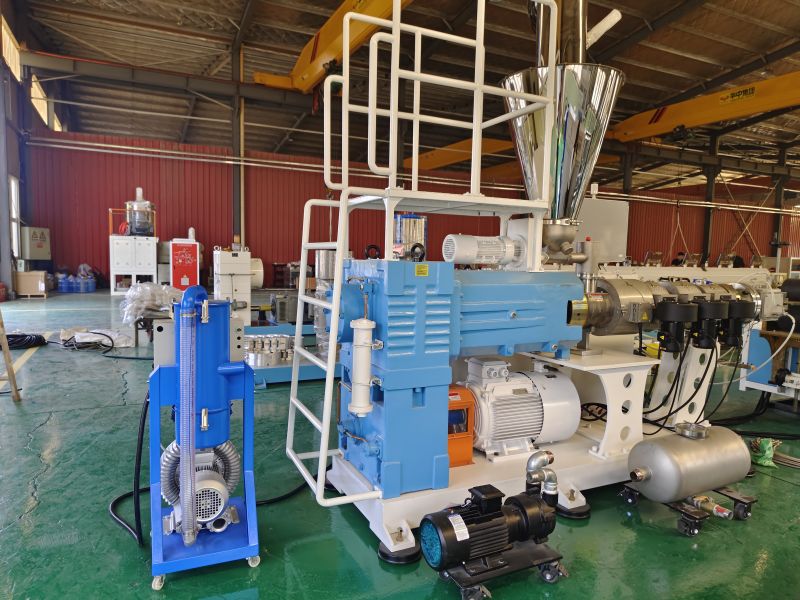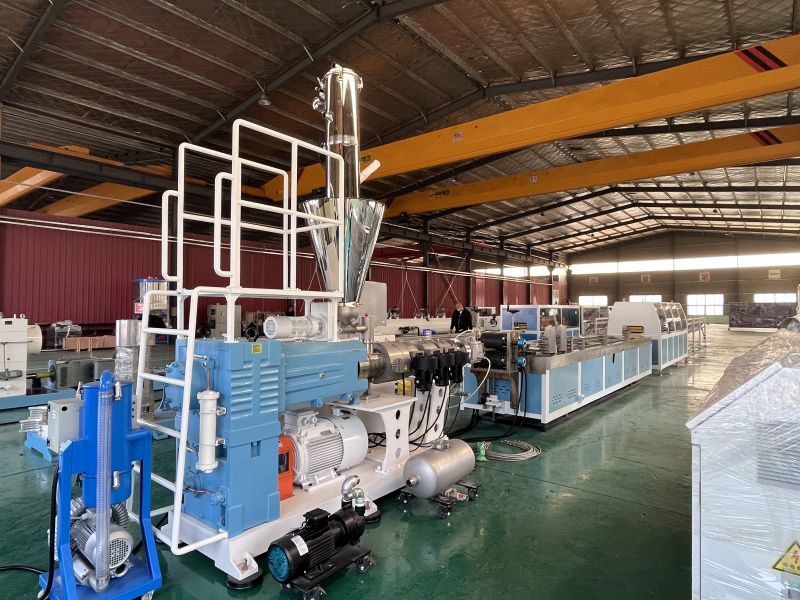In the production process of wood plastic, the following requirements are imposed on extruders:
- Reasonable compression ratio: The wood fiber and plastic in the wood plastic material need to be fully mixed and plasticized, which requires the screw of the extruder to have a suitable compression ratio. If the compression ratio is too small, the material cannot be fully plasticized, which will affect the quality of the product; if the compression ratio is too large, the material will be over-sheared in the screw, which will reduce the performance of the wood plastic material and may also cause the extruder to overload. For wood plastic materials, the compression ratio of the screw is generally between 2.5:1 and 4:1.
- Low shear, high conveying structure: Unlike ordinary plastic extrusion, the wood fiber in the wood plastic material is relatively fragile. Excessive shear force will destroy the structure of the wood fiber and reduce the performance of the material. Therefore, the screw of the extruder should be designed as a low shear, high conveying structure so that the material can pass through the screw smoothly and reduce damage to the wood fiber. For example, the use of a screw with a larger pitch and the reduction of the screw thread depth can reduce the shear force and improve the conveying efficiency.
- Good self-cleaning ability: Wood-plastic materials are easy to adhere to the screw during the extrusion process. If the self-cleaning ability of the screw is poor, it will cause the material to accumulate on the screw, affecting the normal operation of the extruder. Therefore, the surface of the screw should be smooth, and the shape and structure of the thread should facilitate the flow and discharge of the material to ensure that the screw has good self-cleaning ability.

- Wide temperature control range: The extrusion process of wood-plastic materials needs to be carried out within a certain temperature range, and different wood-plastic formulas and production processes have different temperature requirements. Therefore, the extruder should have a wide temperature control range to meet the extrusion temperature requirements of different wood-plastic materials. Generally speaking, the heating temperature range of the extruder is between 150℃ and 250℃.
- High temperature control accuracy: Temperature fluctuations will affect the plasticization effect of wood-plastic materials and the quality of the product, so the temperature control system of the extruder should have high accuracy. The temperature control system should be able to adjust the temperature quickly and accurately so that the temperature fluctuation of the extruder is controlled within a small range. Generally, the temperature fluctuation should be controlled within ±5℃.
- Sufficient power: The extrusion of wood-plastic materials needs to overcome greater resistance, especially when extruding thick-walled or solid products, the extruder needs to have sufficient power to drive the screw to rotate. If the power of the extruder is insufficient, it will lead to problems such as slow extrusion speed and unstable product size. Therefore, the drive motor with appropriate power should be selected according to the characteristics of wood-plastic materials and the requirements of extruded products.
- Stable speed: The screw speed of the extruder should be stable to ensure uniform extrusion speed of the material, thereby ensuring the quality of the product. The drive system should have good speed regulation performance and be able to accurately adjust the screw speed according to the requirements of the production process. At the same time, the drive system should also have an overload protection function. When the extruder encounters abnormal resistance, it can automatically stop to protect the safety of the equipment.
- Accurate feeding amount: The formula ratio of wood-plastic materials has an important influence on the performance of the product, so the feeding system of the extruder should be able to accurately control the feeding amount. The feeding system should have a good metering function and be able to accurately feed according to the set formula ratio. The feeding error should be controlled within a small range, generally not exceeding ±5%.
- Smooth feeding process: Since wood-plastic materials contain wood fibers, bridging and agglomeration are prone to occur, which affects the smoothness of feeding. Therefore, the feeding system should have a good structural design to ensure the smooth flow of materials and avoid the problem of feeding blockage. For example, the use of vibration feeding, spiral feeding and other methods can improve the smoothness of feeding.

- Efficient exhaust system: The wood fibers in wood-plastic materials contain a certain amount of moisture and volatiles, which will produce gas during the extrusion process. If these gases cannot be discharged in time, bubbles will form in the product, affecting the quality of the product. Therefore, the extruder should have an efficient exhaust system that can quickly and effectively exhaust the gas in the material. The design of the exhaust system should be reasonable, and the position and number of the exhaust ports should be able to meet the requirements of exhaust.
- Good sealing: While exhausting, the extruder should also maintain good sealing to prevent external air from entering the extruder, affecting the plasticization effect of the material and the quality of the product. Therefore, the seals of the exhaust system should be made of high-quality materials and should be checked and replaced regularly to ensure the sealing of the exhaust system.
- Corrosion resistance: Since the wood fiber in the wood-plastic material contains organic acids and other components, it has a certain degree of corrosion on the metal parts of the extruder. Therefore, the screw, barrel, mold and other parts of the extruder should be made of corrosion-resistant materials or undergo special surface treatment to improve the corrosion resistance of the equipment and extend the service life of the equipment.
- Wear resistance: The wood fiber and filler components in the wood-plastic material cause great wear on the extruder, especially in the process of high-speed extrusion, the wear problem is more serious. Therefore, the screw, barrel, mold and other parts of the extruder should have high hardness and wear resistance to ensure the normal operation of the equipment.